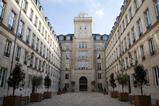The funding ratios of the Netherlands’ largest five pension funds have reached their highest levels since 2008. Civil service scheme ABP recorded the largest rise to 117.4% in March as it benefited from its relatively low interest rate hedge, bringing indexation within reach for the fund.
ABP’s funding ratio has risen by 6.8 percentage points since the start of the year while the other four large sector schemes also saw their funding ratios rise by 1.5 to 4.1 percentage points. The funding ratio rise was entirely due to an increase in interest rates as all five pension funds suffered losses on their investment portfolios.
Metal schemes PMT and PME lost 9% and 8%, respectively, while healthcare fund PFZW registered a return of -7% as equity and bond markets fell due to the war in Ukraine and soaring inflation. ABP managed to limit its losses to -4% thanks to a 27% return on its commodities portfolio.
The rise of the actuarial interest rate for pension funds from 0.6% to 1.1% more than compensated for the investment losses.
According to calculations by PFZW, the higher interest rates translated into an increase of its funding ratio by 11 percentage points, of which half was neutralised by the fund’s interest rate hedge. The losses suffered on its investment portfolio cost the fund another 1.8 percentage points.
Indexation
The higher funding ratios mean indexation is edging closer, not least because indexation rules will be relaxed as of 1 July. As of then, pension funds will be allowed to increase pensions if their policy funding ratio is above 105%, down from 110%.
This is done in anticipation of the transition to a defined contribution system which no longer requires funds to have large buffers.
| Pension Fund | Funding Ratio (%) |
|---|---|
| BpfBouw | 129.2 |
| ABP | 117.4 |
| PME | 110 |
| PFZW | 110 |
| PMT | 108 |
“Increasing pensions is coming another step closer,” ABPs president Harmen van Wijnen said. The fund, which now has a policy funding ratio of 106.5%, will decide in early July by how much it will index pensions, he added.
According to president Eric Uijen of PME, which ended the first quarter of 2022 with a policy funding ratio of 105.3%, the question whether pensions can be indexed depends on many factors.
He said: “We need to take into account the planned pension transition in 2025, but we must still determine the funding ratio needed for this. We prefer to avoid having to cut pensions again later if we index now.”
PMT, which has a policy funding ratio of 103%, also said it is not yet sure it can index pensions at all as it may want to retain a buffer in the run-up to the transition to the new pension system.
An ABP spokesperson noted markets are currently volatile and that the relaxation of the indexation rules has yet to be finalised as parliament is still to approve it.
The latest digital edition of IPE’s magazine in now available














